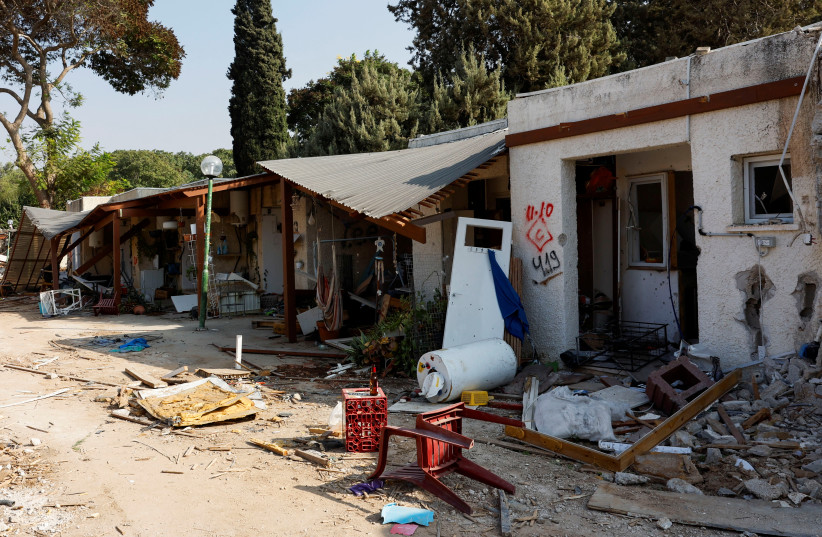On October 7, I woke up early in the morning, before the sun had fully risen. Maybe it was because I have a toddler, maybe because I hadn’t finished my dishes from Shabbat dinner the night before, or maybe because on some existential level, I was connected to the collective subconscious of the Jewish people and was jolted out of anything resembling a restful state, as my life, and all of our lives, have shifted into the new reality of “before” and “after.”
Regardless of the reason, the start of my “after” began in the dark, with only the light of my doom-scrolling to guide the way.
In the nearly six months since the October 7 massacre, there have been many voices that have risen in the cry “It’s still October 7.”
It’s still October 7, a warning against allowing the relentless march of time to dull our pain and a caution to steel ourselves against whatever “moving on” means. Because of course we can’t move on. There are still, as of this writing, 134 hostages, those alive and those whose bodies are being held in Gaza.
There are their traumatized loved ones. There is the family of Am Yisrael, reeling from the double punch of a massacre and the ongoing realization of rising antisemitism, untold indifference at best, and outright hatred at worst.

But as an educator, and a member of the Jewish people, I invite you to join me in a different cry: “It’s not October 7.”
On October 7, we were a people in shock. We were watching the scenes unfold that have become the backdrop of our nightmares. Shiri Bibas, her arms wrapped around her beautiful boys, surrounded by terrorists. Naama Levy, bloody and brave, being forced into a truck.
The heroic Aner Shapira, throwing grenades out of a bomb shelter each time Hamas terrorists lobbed them inside, over and over again, until one exploded and killed him. On October 7, we still believed that the world would join us in our outcry over our missing, our dead, our mutilated.
We are changed since October 7
We are changed since October 7. Some of us are hardened, feeling our hearts close off so as not to raise our hopes up at each new promise of negotiations, of returns, of the eventual tomorrow.
Many of us have experienced awakenings – of Jewish pride, Jewish joy, Jewish strength. And of Jewish vulnerability. We’re figuring out how to navigate between all of these realities.
For the families of the hostages, it’s certainly not October 7. It’s been over 150 days of tireless work, ongoing trauma, and supreme bravery – on behalf of their loved ones. For the soldiers, for the home front, for the Jewish people, we must acknowledge how long this liminal space of war and darkness and yellow ribbons and the impossibly beautiful faces of the missing on posters has gone on and is now shaping who we will forever be moving forward.
So if it’s not October 7, but if we’re not ready to wake up and declare “tomorrow” here, where are we? What is that liminal space between the days?
Twilight in Judaism is when wonders happen.
In Pirkei Avot, we are told, “Ten things were created on the eve of Shabbat at twilight. These are: the mouth of the earth [that swallowed Korach]; the mouth of the well [of Miriam]; the mouth of the donkey [of Balaam]; the rainbow; the manna; the staff (of Moses); the shamir [the worm that cuts through stone]; the letters; the writing; and the tablets [of the 10 commandments] (Pirkei Avot, 5:6).”
Each of these creations is that which is otherwise unexplainable – they don’t fall into the “typical” categories of each day of creation, as they are beyond the boundaries of our understanding of normalcy.
What if we are in the twilight of before and after? When October 7 is not over, has not gone away, as we will not let it go until we are as whole as we can be as a people once again, when a new day has not dawned, but we are seeking it, searching for the stars in the sky to mark the transition? What can that mean for who we are at this moment?
What is the wonder that we can create in this moment? October 7 was, and is, a catalyst moment for the Jewish people. It broke our hearts, and for many of us, that brokenness was also an opening. There has been an awakening since October 7 – of Jewish identity, Jewish pride, the yearning to find and claim Jewish joy in a world that sought to silence it. As a Jewish educator, it is this liminal space in which I believe hard-won, complex beauty can emerge. The beauty that comes from strength. That inspires the desire to encounter the world wholly as you are, and to share that which is core to you – in this case, Jewish joy, as well as Jewish complexity.
What would the proverbial day after look like if we all emerged from the ashes of October 7 with the dignity that comes with embracing Jewish pride? If as the twilight fades and the space becomes solid once again, with unapologetic Jewish strength? It is with this envisioned reality in mind that I hope Jewish educators will take their next steps. Holding the muscles of resilience that we have flexed over the last six months and the strength and the vulnerability that we have shown – and all of the complexities we have held – we at a moment in the twilight when all this will inform the steps we take towards the tomorrow we hope comes soon.
The writer is managing director of Identity, Ideas, and Adolescents at the New York-based Jewish Education Project.
